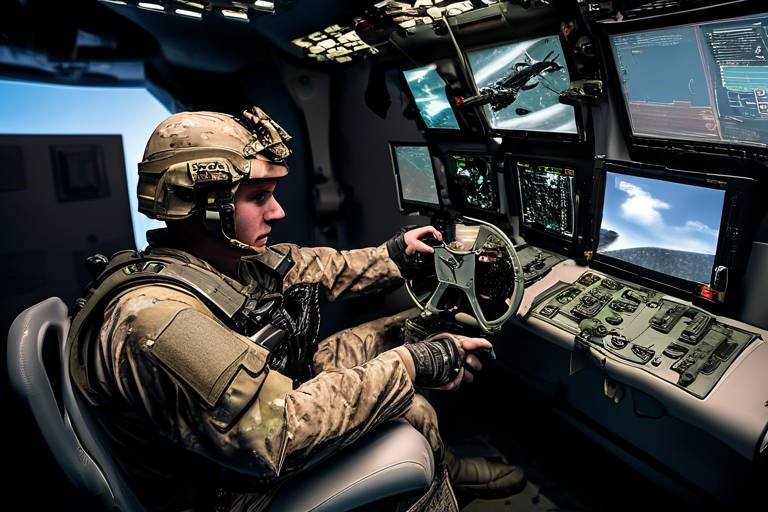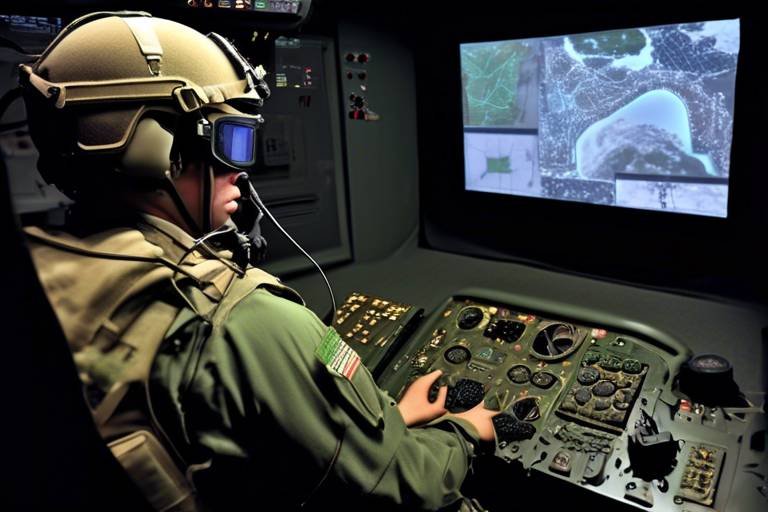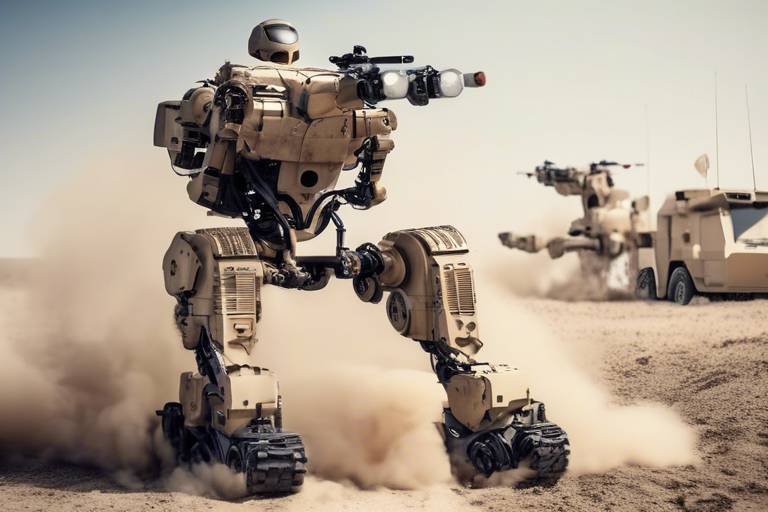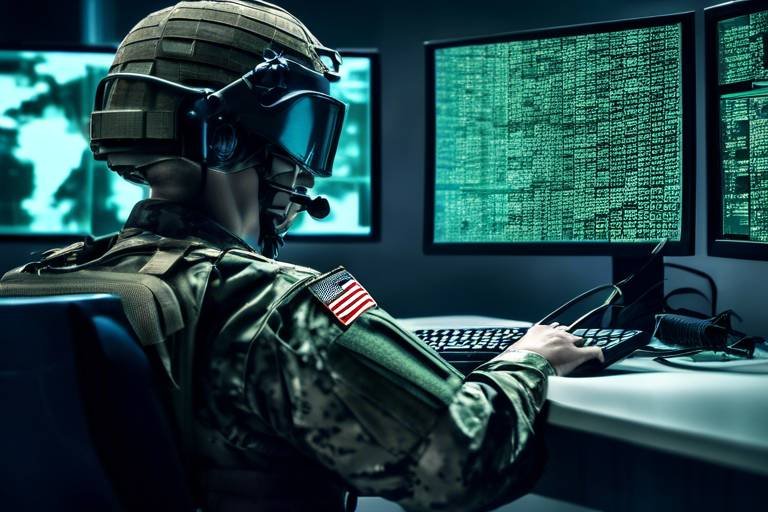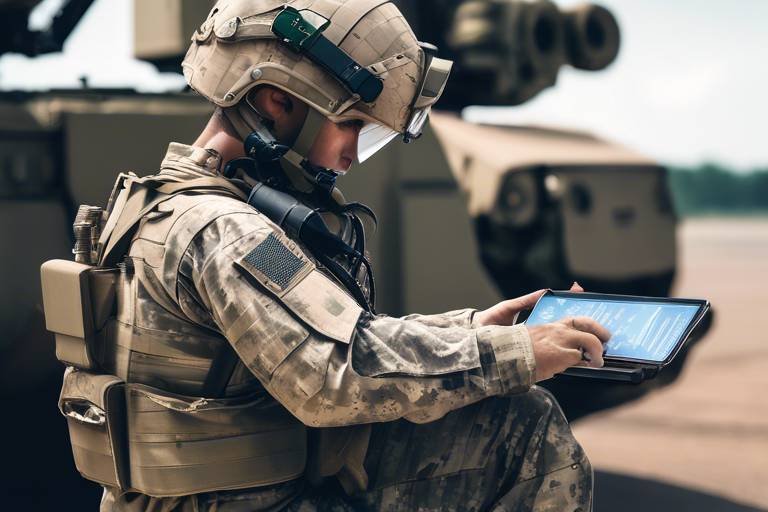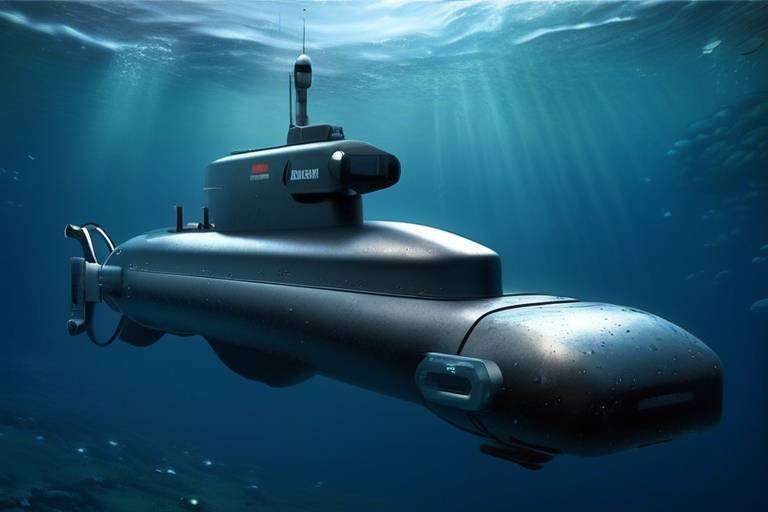AI-Driven Autonomous Aircraft - The Future of Air Combat
The landscape of military aviation is undergoing a radical transformation, driven by the integration of artificial intelligence (AI) into autonomous aircraft. Imagine a future where aircraft can operate independently, making real-time decisions, and executing complex missions without direct human intervention. This isn't just science fiction; it's the emerging reality of air combat. As nations strive to gain the upper hand, AI-driven autonomous aircraft are poised to redefine the rules of engagement in the skies.
Historically, the journey towards autonomous flight began with simple drones, primarily used for reconnaissance. However, with the rapid advancements in technology, we now stand at the brink of a new era. The evolution from rudimentary remote-controlled aircraft to sophisticated AI systems is nothing short of astonishing. These advanced machines are equipped with capabilities that allow them to analyze vast amounts of data, learn from their experiences, and adapt to ever-changing combat scenarios. The implications for military operations are profound, raising questions about strategy, ethics, and the future of warfare.
AI technologies are at the heart of this transformation, enhancing the operational capabilities of autonomous aircraft in unprecedented ways. From machine learning to computer vision, these innovations are enabling aircraft to execute missions with a level of precision and efficiency that was once thought impossible. For instance, imagine an aircraft that can identify and track multiple targets simultaneously, adjusting its tactics on the fly based on real-time data. This capability not only improves the effectiveness of military operations but also reduces the risk to human pilots, who have traditionally been at the forefront of combat missions.
However, the integration of AI into military aviation is not without its challenges. Ethical considerations loom large, as the prospect of machines making life-and-death decisions raises serious moral questions. Additionally, the reliability of these systems must be ensured, as any malfunction in high-stakes situations could lead to catastrophic outcomes. Cybersecurity is another critical concern, as the potential for enemy interference poses a significant risk to the operational integrity of AI-driven aircraft.
Despite these challenges, the role of human oversight remains paramount. While AI can significantly enhance the capabilities of autonomous aircraft, the need for human intervention in critical situations cannot be overstated. Striking a balance between autonomy and control is essential to mitigate risks, especially in unpredictable combat scenarios. Training programs for operators must evolve to equip them with the necessary skills to manage these advanced systems effectively, ensuring they understand their limitations and the importance of human judgment in decision-making processes.
As we look to the future, the trajectory of air combat strategies is set to change dramatically. The proliferation of AI-driven autonomous aircraft will likely shift military tactics, with a greater emphasis on unmanned missions and networked operations. This evolution could alter global power dynamics, as nations race to develop and deploy these advanced systems. The question remains: how will traditional military powers adapt to this new reality, and what implications will it have for international relations?
- What are AI-driven autonomous aircraft?
AI-driven autonomous aircraft are unmanned aerial vehicles (UAVs) that utilize artificial intelligence to operate independently, making decisions in real-time during missions. - How do machine learning algorithms enhance flight operations?
Machine learning algorithms enable autonomous aircraft to learn from past experiences and adapt their strategies in dynamic combat environments, improving overall mission effectiveness. - What are the ethical concerns surrounding AI in combat?
Ethical concerns include the potential for machines to make life-or-death decisions, accountability for actions taken by autonomous systems, and the implications of warfare conducted without human oversight. - How important is human oversight in autonomous aircraft operations?
Human oversight is crucial to ensure accountability and control, especially in high-stakes situations where the consequences of decisions can be severe. - What is the future of air combat with AI technologies?
The future of air combat is likely to see a significant shift towards unmanned operations, with AI technologies enhancing the capabilities and effectiveness of military strategies on a global scale.

The Evolution of Autonomous Aircraft
The journey of autonomous aircraft is nothing short of fascinating. It all began in the early 20th century when the concept of unmanned aerial vehicles (UAVs) first took flight. Initially, these aircraft were rudimentary, primarily serving as targets for training purposes. However, as technology advanced, so did the capabilities and applications of these flying machines. Fast forward to the 21st century, and we find ourselves in an era where AI-driven autonomous aircraft are revolutionizing military operations.
In the early stages, drones were simple remote-controlled devices. They were operated by pilots on the ground, which limited their operational scope and effectiveness. But as the military recognized the potential of these aircraft, significant investments were made into research and development. This led to the creation of more sophisticated systems capable of performing complex missions without direct human intervention. The integration of advanced technologies like GPS navigation, real-time data transmission, and basic automation marked the beginning of a new era in aerial warfare.
As we moved into the 1980s and 1990s, the capabilities of autonomous aircraft began to expand. The introduction of the RQ-1 Predator drone in the mid-1990s was a game changer. This UAV was equipped with surveillance technology and could conduct reconnaissance missions over hostile territories. The Predator's success paved the way for more advanced models, leading to the development of armed drones capable of executing precision strikes. This shift not only enhanced military effectiveness but also raised questions about ethics and the rules of engagement in warfare.
Today, we stand on the brink of a new frontier in aerial combat. The evolution of autonomous aircraft has reached a point where artificial intelligence plays a pivotal role. Modern UAVs are not just remotely operated; they are equipped with sophisticated algorithms that allow them to make real-time decisions based on environmental data. This advancement has transformed them from simple flying machines into intelligent systems capable of executing complex missions autonomously.
To illustrate this evolution, consider the following table that highlights key milestones in the development of autonomous aircraft:
| Year | Milestone | Description |
|---|---|---|
| 1916 | First UAV | The Kettering Bug, an early cruise missile prototype. |
| 1995 | RQ-1 Predator | First UAV to be used for surveillance and combat operations. |
| 2001 | MQ-1 Predator | Armed version of the Predator, capable of precision strikes. |
| 2010 | MQ-9 Reaper | Advanced UAV with enhanced payload capacity and range. |
| 2020+ | AI Integration | Autonomous systems capable of real-time decision-making. |
As we look to the future, the evolution of autonomous aircraft is set to continue at an unprecedented pace. The integration of machine learning, computer vision, and real-time data analytics will redefine what these aircraft can achieve. They will become even more autonomous, capable of adapting to dynamic combat environments, and improving mission success rates. The evolution from simple drones to AI-powered autonomous systems signifies a monumental shift in how air combat will be conducted.
- What are autonomous aircraft? Autonomous aircraft are unmanned aerial vehicles (UAVs) that can operate without direct human control, often using AI to make decisions.
- How have autonomous aircraft evolved over time? They have progressed from basic remote-controlled models to sophisticated AI-driven systems capable of complex missions.
- What role does AI play in autonomous aircraft? AI enhances decision-making, enables real-time data processing, and allows for adaptive responses in dynamic combat situations.
- What are the challenges of using AI in military aviation? Challenges include ethical considerations, reliability issues, and the need for robust cybersecurity measures.

AI Technologies Transforming Air Combat
The landscape of air combat is undergoing a profound transformation, driven by the integration of artificial intelligence (AI) technologies into autonomous aircraft systems. These advancements are not merely incremental; they represent a seismic shift in how military operations are conducted in the skies. From enhancing situational awareness to improving mission efficiency, AI technologies are redefining what is possible in aerial warfare. But what exactly are these technologies, and how are they reshaping air combat strategies?
One of the most significant developments is the implementation of machine learning, which allows autonomous aircraft to learn from data and improve their performance over time. Imagine a fighter jet that can analyze previous combat scenarios, adapt its tactics, and make real-time decisions based on evolving conditions. This capability is akin to having a seasoned pilot who can recall countless missions and apply that knowledge instantaneously. Machine learning algorithms analyze vast amounts of data from various sources, enabling aircraft to identify patterns, predict enemy movements, and optimize their own strategies.
Machine learning is not just about crunching numbers; it fundamentally enhances the aircraft's ability to operate in dynamic environments. For instance, consider a scenario where an autonomous drone is deployed in a conflict zone. It can use machine learning to assess the battlefield conditions, recognize friendly and enemy units, and even predict potential threats. This adaptability is crucial in high-stakes situations where every second counts. As the aircraft processes data from its sensors, it can adjust its flight path, alter its tactics, and ensure mission success.
Another key AI technology making waves in air combat is predictive analytics. By leveraging historical data and real-time information, predictive analytics helps military strategists assess threats and optimize flight paths. Imagine a scenario where a squadron of drones is tasked with surveillance over a hostile area. Using predictive analytics, these drones can calculate the most efficient routes while avoiding potential ambushes. This not only increases the likelihood of mission success but also minimizes risks to personnel and equipment.
Real-time data processing is the backbone of modern autonomous aircraft operations. In the heat of battle, the ability to process information quickly can be the difference between victory and defeat. Autonomous aircraft equipped with advanced sensors and AI algorithms can analyze incoming data from various sources—such as radar, satellite imagery, and even communication signals—within milliseconds. This rapid processing enables them to respond to changing situations and enemy tactics almost instantaneously, ensuring they remain one step ahead in combat scenarios.
To illustrate the impact of these AI technologies, consider the following table that summarizes their benefits:
| AI Technology | Benefits |
|---|---|
| Machine Learning | Adapts tactics based on historical data, enhances decision-making. |
| Predictive Analytics | Assesses threats, optimizes flight paths, increases mission success rates. |
| Real-time Data Processing | Responds swiftly to changing situations, enhances situational awareness. |
As we continue to explore the integration of AI in air combat, it's essential to recognize that these technologies are not just tools; they represent a fundamental shift in military strategy. The combination of machine learning, predictive analytics, and real-time data processing creates a new paradigm where autonomous aircraft can operate with a level of efficiency and effectiveness previously thought impossible. However, as we embrace these advancements, we must also consider the ethical implications and the need for human oversight to ensure that these powerful tools are used responsibly.
- What is the role of AI in modern air combat? AI enhances the capabilities of autonomous aircraft, allowing them to learn, adapt, and respond in real-time to dynamic combat environments.
- How does machine learning improve flight operations? Machine learning enables aircraft to analyze data from past missions, adapt tactics, and make informed decisions in real-time.
- What are the risks associated with AI in military aviation? Key risks include ethical considerations, reliability issues, and the need for robust cybersecurity measures to protect against potential threats.

Machine Learning in Flight Operations
Machine learning is revolutionizing the way autonomous aircraft operate in combat scenarios. Imagine a pilot who never tires, who can process thousands of data points in the blink of an eye, and who learns from every encounter. That’s precisely what machine learning brings to the table. It allows these aircraft to not only execute pre-programmed missions but also adapt to the fluid dynamics of modern warfare. By analyzing vast amounts of data from previous missions, weather patterns, and enemy tactics, machine learning algorithms empower these aircraft to make real-time decisions that can significantly enhance their effectiveness in the field.
One of the most fascinating aspects of machine learning in flight operations is its ability to improve decision-making. Traditional aircraft rely heavily on human pilots who, despite their training, can only process a limited amount of information at once. In contrast, an AI-driven autonomous aircraft equipped with machine learning capabilities can evaluate multiple variables simultaneously. For instance, if an aircraft encounters unexpected enemy fire, it can assess the threat level, evaluate potential evasive maneuvers, and execute the most effective response—all within seconds. This capability not only increases the chances of mission success but also minimizes the risk to human life.
Furthermore, machine learning enables autonomous aircraft to learn from their experiences. Each flight can be viewed as a lesson, where the AI analyzes what worked well and what didn’t. This continuous learning process means that the aircraft becomes smarter over time, refining its tactics and strategies. For example, if a particular maneuver proves successful in avoiding enemy radar detection, the AI can incorporate that knowledge into future missions, making it an invaluable asset on the battlefield.
However, it’s essential to understand that machine learning isn't a magic bullet. There are challenges to overcome, such as ensuring the reliability of the algorithms and the quality of the data being fed into them. If the data is biased or flawed, it could lead to poor decision-making in critical situations. Therefore, rigorous testing and validation are crucial before deploying these systems in real combat scenarios.
In conclusion, the integration of machine learning in flight operations is not just a trend; it’s a paradigm shift that could redefine air combat strategies. As these technologies continue to evolve, we can expect to see autonomous aircraft that are not only capable of executing complex missions but also capable of making informed decisions that could turn the tide of battle. The future of military aviation is indeed exciting, and machine learning is at the forefront of this transformation.
- What is machine learning in the context of autonomous aircraft?
Machine learning refers to the use of algorithms that enable autonomous aircraft to learn from data, adapt to new situations, and make decisions without human intervention.
- How does machine learning enhance decision-making in combat?
Machine learning allows aircraft to analyze multiple data points in real-time, enabling them to react swiftly and effectively to changing combat conditions.
- What are the challenges of implementing machine learning in military aviation?
Challenges include ensuring data quality, algorithm reliability, and addressing ethical concerns regarding autonomous decision-making in combat scenarios.
- Can machine learning systems improve over time?
Yes, machine learning systems can learn from past experiences, refining their tactics and strategies to become more effective in future missions.

Predictive Analytics for Mission Success
In the high-stakes world of air combat, predictive analytics has emerged as a game-changer, significantly enhancing mission success rates. This technology leverages vast amounts of data to forecast potential outcomes, allowing military strategists to make informed decisions before engaging in combat. Imagine having a crystal ball that not only shows you what might happen next but also guides you on how to respond effectively. That's exactly what predictive analytics offers to autonomous aircraft.
At its core, predictive analytics uses algorithms to analyze historical data, identify patterns, and generate insights. For instance, an autonomous aircraft equipped with this technology can assess previous engagements, enemy behavior, environmental factors, and even logistical challenges to anticipate threats. This capability is akin to a seasoned chess player who can foresee multiple moves ahead, adjusting their strategy in real-time to counteract the opponent's tactics.
One of the most significant advantages of predictive analytics is its ability to optimize flight paths. By evaluating various scenarios, autonomous systems can calculate the safest and most efficient routes to achieve their objectives while minimizing exposure to enemy fire. This not only enhances the survivability of the aircraft but also increases the likelihood of mission success. In essence, it transforms the aircraft into a tactical powerhouse, capable of navigating complex combat environments with ease.
Moreover, predictive analytics can play a crucial role in threat assessment. By continuously monitoring the battlefield and analyzing incoming data, autonomous aircraft can identify emerging threats before they escalate. This proactive approach allows military forces to adapt their strategies promptly, ensuring they stay one step ahead of adversaries. For instance, if an enemy radar system is detected, predictive analytics can suggest evasive maneuvers or alternative attack strategies, effectively neutralizing the threat.
To illustrate the impact of predictive analytics, consider the following table that summarizes its key benefits:
| Benefit | Description |
|---|---|
| Enhanced Decision-Making | Provides data-driven insights for strategic planning and execution. |
| Improved Flight Path Optimization | Calculates the safest and most efficient routes for missions. |
| Proactive Threat Assessment | Identifies potential threats before they become critical. |
| Increased Mission Success Rates | Utilizes historical data to improve outcomes in complex scenarios. |
In conclusion, the integration of predictive analytics into autonomous aircraft is not just a technological advancement; it's a revolutionary shift in how military operations are conducted. By harnessing the power of data, military forces can enhance their strategic capabilities, making informed decisions that lead to greater mission success. As we move forward, the reliance on predictive analytics will only deepen, shaping the future of air combat in ways we are just beginning to understand.
- What is predictive analytics? Predictive analytics is a technology that uses data analysis and algorithms to forecast potential outcomes and guide decision-making.
- How does predictive analytics improve mission success? By analyzing historical data and identifying patterns, predictive analytics helps military strategists make informed decisions, optimize flight paths, and assess threats proactively.
- Can predictive analytics be used in real-time during combat? Yes, predictive analytics can process real-time data to adapt strategies and respond quickly to changing combat scenarios.
- What are some challenges of implementing predictive analytics in military operations? Challenges include the need for robust data security, the potential for over-reliance on technology, and the integration of predictive systems with existing military frameworks.

Real-time Data Processing
In the fast-paced world of air combat, stands out as a game changer, akin to having a crystal ball that reveals the battlefield's secrets. Imagine an autonomous aircraft soaring through the skies, equipped with the ability to process vast amounts of data instantaneously. This capability allows these aircraft to make informed decisions on the fly, adapting to ever-changing combat situations with remarkable agility. The integration of real-time data processing into autonomous systems is not just a technical advancement; it’s a revolution that enhances situational awareness and operational efficiency.
One of the key components of real-time data processing is the ability to analyze information from multiple sources, including satellite feeds, radar systems, and ground-based sensors. This multifaceted approach enables autonomous aircraft to build a comprehensive picture of the battlefield, identifying threats and opportunities that may not be immediately visible. For instance, while traditional aircraft might rely on pre-programmed flight paths, AI-driven systems can dynamically adjust their routes based on real-time intelligence, optimizing their strategies and ensuring mission success.
Moreover, the speed at which data is processed is critical. In air combat, seconds can mean the difference between victory and defeat. By leveraging cutting-edge technologies such as edge computing and cloud-based analytics, autonomous aircraft can execute complex calculations and simulations in mere milliseconds. This capability enables them to respond to enemy maneuvers or environmental changes without lag, effectively turning them into agile predators in the sky.
To illustrate the impact of real-time data processing, consider the following table that highlights its benefits:
| Benefit | Description |
|---|---|
| Enhanced Decision-Making | Autonomous aircraft can analyze data rapidly, leading to quicker and more accurate decisions during combat. |
| Increased Situational Awareness | Real-time processing allows for continuous monitoring of the battlefield, providing pilots and ground control with up-to-date information. |
| Adaptive Strategies | AI systems can modify flight paths and tactics based on immediate threats and opportunities, improving mission outcomes. |
| Reduced Human Error | By automating data analysis, the risk of human error is significantly minimized, leading to safer and more effective operations. |
However, the implementation of real-time data processing is not without its challenges. High-speed data transmission requires robust cybersecurity measures to prevent enemy interference or hacking attempts. Additionally, the sheer volume of data can overwhelm systems if not managed properly, leading to potential information overload. Therefore, developing efficient algorithms and maintaining secure networks are essential for the success of these advanced technologies.
As we look to the future, the role of real-time data processing in autonomous aircraft will only grow. It promises to redefine air combat strategies, making them more fluid and responsive. The ability to process and act on information in real-time will not only enhance the effectiveness of military operations but also reshape the very nature of warfare itself.
- What is real-time data processing in autonomous aircraft?
Real-time data processing refers to the capability of autonomous aircraft to analyze and respond to data from various sources instantaneously, allowing them to make informed decisions on the battlefield. - How does real-time data processing enhance combat effectiveness?
It enhances combat effectiveness by improving situational awareness, enabling adaptive strategies, and reducing human error, ultimately leading to quicker and more accurate decision-making. - What challenges are associated with real-time data processing?
Challenges include the need for robust cybersecurity measures, the risk of information overload, and the requirement for efficient data management algorithms. - What technologies are involved in real-time data processing?
Technologies such as edge computing, cloud-based analytics, and advanced algorithms play a crucial role in enabling real-time data processing for autonomous aircraft.

Challenges of Implementing AI in Combat
The integration of AI technologies into military aviation is not without its hurdles. While the potential advantages are enticing, the challenges must be carefully navigated to ensure successful implementation. One major concern is ethical considerations. The idea of machines making life-and-death decisions raises profound moral dilemmas. Who is accountable when an autonomous aircraft makes a mistake? This question looms large over military strategists and ethicists alike. The implications of delegating such critical decisions to AI systems can lead to a slippery slope of accountability.
Another significant challenge is ensuring the reliability of AI systems. In the chaotic environment of combat, autonomous aircraft must perform flawlessly under pressure. Any malfunction or misjudgment could lead to catastrophic consequences, not just for the mission but also for friendly forces and civilians on the ground. As a result, rigorous testing and validation of AI-driven systems are essential. The military must invest in extensive simulations and real-world testing to build trust in these technologies, ensuring they can withstand the unpredictability of combat scenarios.
Moreover, the cybersecurity aspect cannot be overlooked. As autonomous aircraft become more interconnected and reliant on data, they also become more vulnerable to hacking and cyberattacks. A compromised AI system could be manipulated to turn against its operators or to execute unintended actions. Therefore, robust cybersecurity measures are imperative to safeguard these advanced systems. This includes not only protecting the aircraft themselves but also securing the data networks that support their operations.
In addition to these technical challenges, there is the issue of human factors. Integrating AI into combat operations requires a paradigm shift in how military personnel are trained and how they interact with these systems. Operators must develop a deep understanding of AI capabilities and limitations, ensuring they can effectively manage and intervene when necessary. This necessitates advanced training programs that focus not only on operating the technology but also on making critical decisions in conjunction with AI systems.
To summarize, the challenges of implementing AI in combat are multifaceted and complex. They encompass ethical dilemmas, reliability concerns, cybersecurity threats, and the need for comprehensive training. Addressing these challenges is crucial for the military to harness the full potential of AI-driven autonomous aircraft while ensuring operational effectiveness and ethical integrity.
- What are the ethical concerns surrounding AI in combat?
The ethical concerns primarily revolve around accountability for decisions made by autonomous systems and the potential for unintended consequences in combat situations. - How can the reliability of AI systems be ensured?
Ensuring reliability involves rigorous testing, simulations, and real-world training to validate the performance of AI systems under various combat scenarios. - What role does cybersecurity play in AI-driven combat?
Cybersecurity is crucial for protecting AI systems from hacking and manipulation, which could lead to catastrophic outcomes in military operations. - Why is human oversight important in AI operations?
Human oversight is essential to maintain accountability and control, ensuring that decisions made by AI systems align with military objectives and ethical standards.

The Role of Human Oversight
In a world where technology is evolving at lightning speed, the integration of AI-driven autonomous aircraft into military operations presents a unique set of challenges and opportunities. While these high-tech machines can execute complex tasks with remarkable efficiency, the importance of human oversight cannot be overstated. Think of it this way: even the most advanced autopilot systems in commercial aviation require a skilled pilot to monitor and intervene when necessary. Similarly, in combat scenarios, human oversight serves as a crucial safety net, ensuring that autonomous systems do not operate in a vacuum.
One of the core reasons for maintaining human oversight is the unpredictable nature of air combat. The battlefield can change in an instant, with new threats emerging and tactics evolving rapidly. Autonomous aircraft, despite their sophisticated algorithms, may struggle to interpret the nuances of such dynamic environments. Here, human operators bring invaluable experience and intuition to the table, allowing them to make judgment calls that a machine might not be programmed to handle. This is especially critical in high-stakes situations where split-second decisions can mean the difference between mission success and failure.
Moreover, the ethical implications of deploying autonomous systems in combat highlight the need for human involvement. Questions arise about accountability: if an autonomous aircraft makes a mistake, who is responsible? By ensuring that human operators are in the loop, military forces can maintain a level of accountability that aligns with international laws and ethical standards. This oversight is essential in preventing potential war crimes or violations of human rights that could arise from fully autonomous decision-making.
To effectively manage AI-driven systems, military personnel must undergo rigorous training. This training should not only focus on operating the technology but also on understanding its limitations. Operators need to be well-versed in the capabilities and potential failings of the systems they control. For instance, while a machine may excel in data processing and threat assessment, it may lack the emotional intelligence to gauge the broader implications of its actions. Thus, comprehensive training programs should incorporate simulations that mimic real-world combat scenarios, allowing operators to practice decision-making under pressure.
In conclusion, while AI-driven autonomous aircraft represent a significant leap forward in military aviation, the role of human oversight remains indispensable. It is about striking a balance between leveraging cutting-edge technology and ensuring that human judgment and ethical considerations guide operations. As we move into an era where these systems become more prevalent, the collaboration between human operators and autonomous technology will define the future of air combat.
- Why is human oversight necessary in autonomous aircraft?
Human oversight is crucial to ensure accountability, make nuanced decisions in unpredictable situations, and maintain ethical standards in combat. - What training do operators need for managing AI-driven aircraft?
Operators require extensive training that includes understanding the technology's capabilities, limitations, and practicing decision-making through simulations. - How does human oversight prevent ethical issues in combat?
By involving human operators, military forces can ensure that actions taken by autonomous systems adhere to international laws and ethical guidelines.

Balancing Autonomy and Control
As we venture deeper into the realm of AI-driven autonomous aircraft, one of the most pressing questions arises: how do we maintain a balance between the impressive capabilities of these machines and the essential need for human oversight? It's a bit like letting a teenager drive for the first time; you want to give them the freedom to learn and explore, but you also want to keep a watchful eye to ensure their safety and the safety of others. In the context of military operations, this balance becomes even more critical, as the stakes are significantly higher.
The integration of autonomous systems into air combat is not just about unleashing powerful technology; it is about creating a framework where machines can operate effectively while still being guided by human judgment. This requires a careful consideration of several factors:
- Decision-Making Protocols: Establishing clear protocols for when and how an autonomous system can make decisions independently versus when it should defer to human operators is crucial. This ensures that in high-pressure situations, the right choices are made swiftly.
- Situational Awareness: Human operators must maintain a comprehensive understanding of the battlefield. This means that while AI can process vast amounts of data and provide insights, the final decisions should still incorporate human intuition and experience.
- Feedback Loops: Creating robust feedback mechanisms allows operators to learn from the AI’s actions and vice versa. This continuous learning process can enhance the effectiveness of both the autonomous systems and the human operators.
Moreover, the unpredictability of combat situations necessitates a flexible approach. Just as a seasoned chess player anticipates potential moves and counters, military operators must be prepared to adapt to the unexpected maneuvers of adversaries. This adaptability is where human intuition shines, complementing the analytical prowess of AI systems.
Furthermore, ethical considerations play a significant role in this balance. The question of accountability arises: if an autonomous aircraft makes a decision that results in unintended consequences, who is responsible? By retaining human oversight, we can instill a sense of accountability that is often lacking in fully autonomous operations. This ensures that there is a human touch in the decision-making process, which is especially vital in military contexts where lives are at stake.
In conclusion, striking the right balance between autonomy and control is not just a technical challenge but a philosophical one. As we continue to innovate and integrate AI into air combat, we must remain vigilant in ensuring that technology serves as an extension of human capability rather than a replacement. This balance will not only enhance operational effectiveness but also uphold the ethical standards that govern military engagements.
- What is the role of human oversight in autonomous aircraft? Human oversight ensures accountability, enhances situational awareness, and provides ethical guidance in decision-making processes.
- How does AI improve decision-making in combat? AI enhances decision-making by processing large amounts of data quickly, identifying patterns, and suggesting optimal strategies based on real-time information.
- What are the ethical concerns regarding autonomous military systems? Ethical concerns include accountability for decisions made by AI, the potential for unintended consequences, and the moral implications of using autonomous systems in warfare.
- Can autonomous aircraft operate without human intervention? While autonomous aircraft can perform many tasks independently, human intervention remains crucial in complex and unpredictable combat environments.

Training and Simulation for Operators
As we dive deeper into the realm of AI-driven autonomous aircraft, one aspect that cannot be overlooked is the critical importance of training and simulation for operators. Just as a skilled pilot must master the intricacies of flying a conventional aircraft, operators of autonomous systems must navigate a complex landscape filled with unique challenges and technological nuances. The stakes are incredibly high in military operations, where the margin for error is slim, and the consequences of misjudgment can be catastrophic.
Training programs for operators need to be meticulously designed to ensure that personnel are not only familiar with the technology but also capable of making quick and informed decisions in high-pressure situations. This involves a multi-faceted approach that combines theoretical knowledge with practical experience. In essence, operators must become adept at understanding both the capabilities and limitations of the AI systems they oversee.
One effective method of preparing operators is through realistic simulation environments. These simulations can replicate various combat scenarios, allowing operators to practice their responses to different situations without the risks associated with actual combat. For instance, operators can engage in scenarios where they must respond to unexpected enemy maneuvers or adapt to changing mission parameters. This hands-on experience is invaluable, as it helps build confidence and enhances decision-making skills under pressure.
Moreover, simulations can be tailored to include elements of team coordination, where operators must work in tandem with other military assets. This is crucial because modern air combat is rarely a solo endeavor; it often involves a coordinated effort among various platforms, including ground troops, naval forces, and other aerial units. Training in a simulated environment fosters a sense of teamwork and communication that is essential for mission success.
In addition to simulations, ongoing education is vital. The field of AI is rapidly evolving, and operators must stay updated on the latest advancements and tactics. This can be achieved through continuous learning programs that cover new technologies, software updates, and emerging combat strategies. By fostering a culture of lifelong learning, military organizations can ensure that their personnel remain at the forefront of technological advancements.
To further enhance the training experience, military organizations can utilize a combination of virtual reality (VR) and augmented reality (AR) technologies. These immersive tools can provide operators with a more engaging and realistic training environment, enabling them to visualize complex scenarios and interact with virtual elements as if they were in the field. This not only boosts retention rates but also prepares operators for the unpredictability of real-world combat.
In conclusion, the integration of AI-driven autonomous aircraft into military operations necessitates a robust training framework that emphasizes both simulation and continuous education. By investing in comprehensive training programs, military forces can ensure that their operators are well-equipped to handle the challenges of modern air combat. Ultimately, the effectiveness of these systems will heavily depend on the human element behind the controls, making operator training an indispensable component of successful military strategy.
- What is the role of simulations in training operators for autonomous aircraft?
Simulations provide a safe environment for operators to practice responding to various combat scenarios, enhancing their decision-making skills and teamwork. - How important is ongoing education for operators?
Ongoing education is crucial as it keeps operators updated on the latest advancements in AI technology and combat strategies, ensuring they remain effective in their roles. - What technologies are being used to enhance training?
Virtual reality (VR) and augmented reality (AR) technologies are increasingly being used to create immersive training experiences for operators. - Why is understanding AI limitations important for operators?
Understanding the limitations of AI systems helps operators make informed decisions and avoid over-reliance on technology, which is essential in unpredictable combat environments.

The Future of Air Combat Strategies
The landscape of air combat is rapidly evolving, and it’s all thanks to the integration of AI-driven autonomous aircraft. As these technological marvels become more prevalent, they are set to revolutionize military tactics and strategies in ways we can only begin to imagine. Picture a battlefield where aircraft can make split-second decisions, adapting to threats and opportunities without waiting for human input. This is not science fiction; it’s the reality we are heading towards. The future of air combat will be characterized by a blend of autonomy and human oversight, creating a dynamic interplay that enhances operational effectiveness.
As we look ahead, it's crucial to consider how AI technologies will shape military strategies. We can expect a significant shift in how commanders approach air combat, with an emphasis on leveraging data analytics and machine learning to inform decisions. For instance, autonomous aircraft equipped with advanced sensors will be able to gather and analyze vast amounts of data in real-time, providing commanders with insights that were previously unattainable. This capability will lead to a more proactive approach to combat, where strategies are constantly refined based on live data rather than relying solely on pre-planned tactics.
Moreover, the integration of swarm technology—where multiple autonomous aircraft operate in unison—will redefine engagement strategies. Imagine a fleet of drones working together, communicating and coordinating their actions to overwhelm enemy defenses. This concept of 'swarming' can create a tactical advantage by complicating the enemy's response, making it difficult to target individual units amidst the chaos. The synergy of these autonomous units could lead to a new era of air dominance, where traditional notions of air superiority are challenged.
However, with great power comes great responsibility. The ethical implications of using AI in combat cannot be overlooked. As we embrace these advancements, we must also grapple with questions of accountability and the potential for unintended consequences. The military must establish clear guidelines and frameworks to govern the use of autonomous aircraft, ensuring that they are deployed responsibly and in accordance with international laws.
Additionally, the future of air combat strategies will likely see an increased emphasis on cybersecurity. As autonomous systems become more integrated into military operations, they also become more vulnerable to cyber attacks. Protecting these systems from malicious actors will be paramount, requiring ongoing investment in robust cybersecurity measures. The military will need to not only defend its aircraft from physical threats but also safeguard against digital ones, ensuring that their autonomous capabilities cannot be compromised.
In conclusion, the future of air combat strategies is poised for transformation through the integration of AI-driven autonomous aircraft. As these technologies evolve, they will provide unprecedented advantages in terms of speed, efficiency, and adaptability. However, it is essential to navigate the accompanying challenges carefully, balancing the benefits of autonomy with the need for human oversight and ethical considerations. The next decade will be critical in shaping how we approach air combat, and it will be fascinating to witness how these advancements unfold on the global stage.
- What are AI-driven autonomous aircraft?
AI-driven autonomous aircraft are unmanned aerial vehicles (UAVs) that use artificial intelligence to operate independently or semi-independently in military operations.
- How will AI change air combat?
AI will enhance decision-making, improve mission efficiency, and allow for real-time data processing, leading to more effective combat strategies.
- What are the ethical concerns surrounding AI in military operations?
Concerns include accountability for decisions made by autonomous systems, the potential for misuse, and compliance with international laws.
- Can autonomous aircraft be hacked?
Yes, as they become more integrated with digital networks, the risk of cyber attacks increases, necessitating strong cybersecurity measures.
Frequently Asked Questions
- What are autonomous aircraft?
Autonomous aircraft are unmanned aerial vehicles (UAVs) that can operate without direct human control. They utilize advanced technologies, particularly AI, to navigate, make decisions, and execute missions in various environments, including military operations.
- How is AI transforming air combat?
AI is revolutionizing air combat by enhancing the capabilities of autonomous aircraft. Technologies like machine learning, computer vision, and real-time data processing enable these aircraft to adapt to dynamic combat situations, improve decision-making, and optimize mission outcomes.
- What role does machine learning play in autonomous aircraft?
Machine learning allows autonomous aircraft to learn from their experiences and adapt to changing conditions in real-time. This adaptability improves their effectiveness in combat scenarios, enabling them to make better decisions based on the data they collect during missions.
- What challenges are associated with implementing AI in military aviation?
There are several challenges, including ethical concerns about decision-making in combat, the reliability of AI systems, and the need for robust cybersecurity to protect against potential threats. These issues must be addressed to ensure the safe and effective use of AI in military operations.
- Why is human oversight important in AI-driven aircraft?
Human oversight is crucial because it ensures accountability and control in high-stakes situations. While AI can make decisions quickly, humans are needed to provide context, ethical considerations, and intervention when necessary, especially in unpredictable combat environments.
- How can operators be trained to manage AI-driven systems?
Operators can be trained through advanced simulation programs that mimic real combat scenarios. This training helps them understand the capabilities and limitations of AI systems, ensuring they can effectively manage and intervene when needed during missions.
- What does the future hold for air combat strategies with AI?
The future of air combat strategies is likely to shift significantly as AI-driven autonomous aircraft become more prevalent. This could lead to new military tactics, changes in global power dynamics, and a re-evaluation of traditional combat roles as technology continues to evolve.








